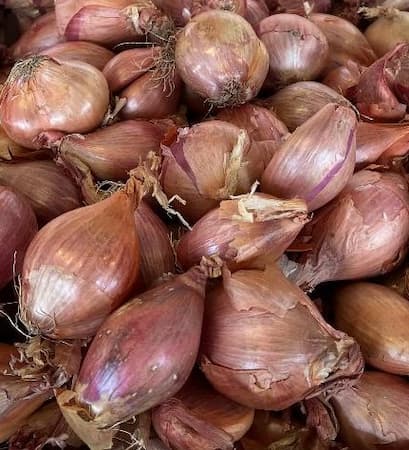How to Grow Shallots Onion Plants

A member of the onion family, Shallot bulbs are considered the best for gourmet cooking. Unlike other onions, Shallots have cloves….like garlic. They have a mild onion and garlic flavor. And, they are easy to grow. Use this plant guide on “How to Grow Shallots” and you’re on your way to growing a great gourmet treat.
While there are a few varieties, the French Shallot, also called “Grey Shallot”, is the most popular, They are considered the “True” shallot by gourmet chefs.
Varieties of Shallots
French or Grey
Banana
Dutch
Frog
Red
How to Grow Shallots
Growing Shallots is easy. And they take up very little space. Plant and grow them like garlic or onions.
The plants grow in average, well-drained soil. Mix organic matter into the soil before planting, for best results. In poor soils, also mix in a general-purpose fertilizer.
The plants prefer moist to slightly dry soil.
The best time to plant shallot bulbs in the fall. They can also be planted in the Spring. Plant cloves 6″-8″ apart, sowing them just below the surface, with the pointed end up.
Add a layer of mulch, to retain soil moisture, and help keep weeds down. For best results, remove competing weeds regularly.
Water plants when the soil begins to dry out. Add a general-purpose fertilizer about a month after planting.
Ideal Soil pH: 6.0 – 7.0
Also, see:
Soil Temperatures – Ideal germination temperature by vegetable
Ideal Soil pH – by vegetable
Insects and Plant Disease
Shallots are resistant to most insect problems. Root maggots can attack the bulbs. Tiny thrips are an occasional problem. Insecticidal soap sprays or sevin are very effective.
The plants usually experience few disease problems. Wet, and humid weather can increase the likelihood of disease. Bulbs can rot in wet soils.
Plant Problems – Diagnosis, causes, and cures for many common plant problems.
Harvesting Bulbs
Days to Harvest: 60 to 100 days., depending upon the variety.
Dig up shallots after the plant leaves have yellowed or fallen over. Rinse off dirt and allow the bulbs to dry in the open air for a several days. Cut the top and the roots of the plant. Allow the cuts to air dry for two or three more days.
Store bulbs in a cool, dry place out of direct sunlight.
Plant Hardiness
Like onion plants, shallots are as hardy as they come. Frosts, freezing temperatures, and even snow will not kill them. It will only slow their growth, until warmer weather returns. Extended cold below 20-25 degrees, however, can kill them, if they are growing when exposed.
Please support our site. Shop for:
- rmmatthews100@hotmail.com
- 585-721-6528
- Rochester, NY
©1999-2024 GardenersNet.Com, All Rights Reserved

